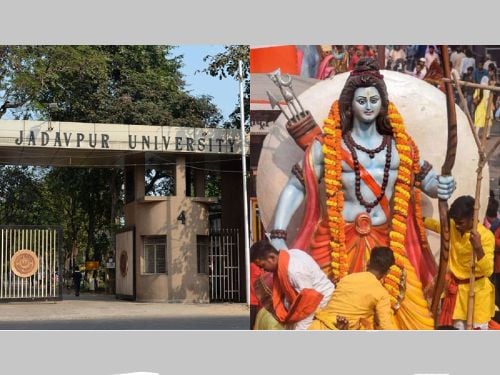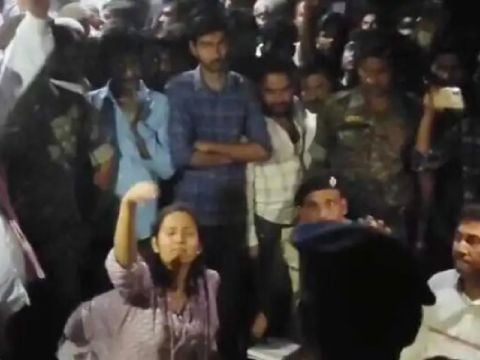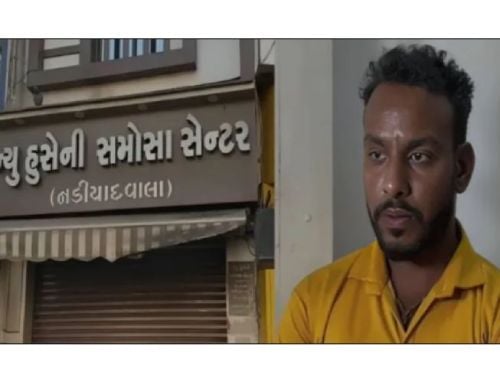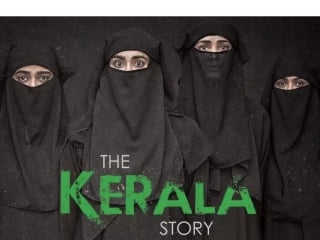Phalgun Krushnapaksha 7, Kaliyug Varsha 5116
By Dr. Pramod Pathak
In the book “The Hindus: An Alternative History” Wendy Doniger has devoted one complete chapter, chapter 9 to the great epic Ramayana. The title is queer however. It reads “Women and Ogresses in Ramayana: 400 BCE to 200 CE”.
One reads very little about ogresses in chapter and the only woman discussed at length obviously is Sita. According to Wendy, Ramayana story “weaves together the themes of dangerous sexuality, the violation of Dharma, compassion towards animals, attitude towards tribal peoples and the transmutation of animal passions into human culture – all central to the concerns of this chapter” (Page 212). It makes her stand clear. The epic which has been revered by the Hindus at large for centuries, characters from which have been equivocally revered by them are of no importance to her. She is searching for base instincts of sexuality and animal passions in this great epic. Keeping aside the socio-cultural background as she thinks of the era, 400BCE to 200 CE, her so called analysis of the characters from Ramayana is laced with utter untruths and twisted conclusions that more or less are directed at defiling the character of the hero of the epic Rama and his wife Sita. While the Hindus have revered Rama as incarnation of Lord Vishnu, an ideal for the human beings, Wendy is bent on showing him to be a base character and utterly suspicious husband. Since she often quotes the references from the Ramayana text, the present author too has referred to the original Sanskrit text of Valmiki Ramayana. There are two editions of Ramayana, namely the traditional text with what is known as “Tilak Tika text of Ramayana” i.e. Ramayana text with Tilak commentary published in 1930. Another is the critical edition of Ramayana published by the Oriental Institute, Baroda in 1965and onwards. While the critical edition has its own importance, the traditional Tilak Tika text has been there for centuries and formed basis for popular conceptions about the characters from the text. Wendy has given references based on the critical edition. In the text below I have referred to critical edition and wherever I have referred to Tilak Tika text of Ramayan, it is mentioned as TTR. All the references from critical edition are to be found in TTR with different numbering.
Appropriating the stories from Buddhist and Jain texts
On page 223 Wendy deals at length with the stories from Buddhist and Jain texts where Rama story appears with some variations. There she states that the author of Ramayana, implying in general the ascending Hindu ethos around that time, “appropriated other peoples stories” i.e. stole, plagiarized the stories from these texts. Wendy is known for her in depth study of the Vedic and the post Vedic literature. How come she has forgotten that Rama’s ancestor Ikshavaku is mentioned in the Rig Veda text in RV 10.60.4. It indicates that Rama’s family lineage dated back by several centuries. Ayodhya is allegorically mentioned in the Atharva Veda text. Lord Buddha visited the city Ayodhya twice, obviously because at that time, it was a pilgrimage centre and there Lord Buddha could preach His doctrine. Why was it a sacred city? It was because of its association with the Ramayana story. In the Buddhist and the Jain texts it is referred to as Ayojza and Saket. Although Ramayana part text was formalized in textual format in the post Buddha period, the story in its entirety existed much before Buddha. Word “Rama” dates back to the Rig Vedic times where it indicated blackness. Thus Rama’s appearance as a black hero can be traced to the Rig Vedic lore. So there is no question of Hindus appropriating the Buddhist or Jain story but it was suitably adopted (and not stolen) by both these later dated texts.
Sita’s confinement in Lanka: for years or months ?
After dealing with the socio-cultural information from page 212 to 220, on page 220 Wendy narrates Ramayana story in short (P220-221). She commits here a biggest gaffe. She states, “Ravana stole Sita and kept her captive on the island of Lanka for many years” (P 221). She repeats the same statement on P 224 and 232. In both the instances she does not clarify whether it is her own perception. Because , anybody who has known the Ramayana story will recall that Sita was confined in Lanka for a few months only. In fact Ravana had given her the period of only six months to yield to his wishes. Nowhere in the text Wendy has clarified as to why she has prolonged the period of a few months to few years. It is unpardonable mistake for a scholar like Wendy, who has, in many of her earlier papers exhibited precision and exactness.
In the same passage Wendy strangely states, “he (Rama) forced her to submit to an ordeal by fire” (P221). Well, it is far from truth. Rama only asserts that he had fulfilled his duty of freeing Sita, killing Ravana and that she was free to go wherever she liked, not to be in bed as Wendy implies, but to lead life in materially and spiritually safe environment. It was Sita who opted for the ordeal by fire, without any prompting or hint from Rama to perform any ordeal. Wendy has negated herself when she quotes from the text, “ (Lakshmana) Build a pyre for me; that is the medicine for this calamity. I cannot go on living, ruined by false accusations” (P 224) . Why has Wendy twisted the narration? Because she desired to show Rama, the most ideal personality for the Hindus, in bad light as inconsiderate and suspicious husband. That is the type of narration all through the chapter.
Kaikeyi’s blackmail
Wendy states that Dasharatha’s youngest queen Kaikeyi uses sexual blackmail to force Dasharatha to put her son Bharat on the thrown and send Rama into exile” (P223). It was not sexual blackmail. She takes help of two boons the King had given her earlier. These were held back by her as rain cheques (For American Wendy to understand in American slang) to be encashed later. When she reminded about the boons, Dasharatha was left with no argument but to plead her to withdraw. But Wendy sees here Kaikeyi’s sexual blackmail. All through the chapter Wendy looks for sexuality and mistrust. For that she makes over statements or writes outright lies.
Sita's final abode
While proving her chastity for the second time, Sita offered herself to the earth mother from where she had emerged. As per the Hindu belief her ultimate abode is heaven as she is Laxmi incarnate. No Hindu may ever have thought that Sita would have leaved till eternity within the earth only. Even if that question be asked to any Hindu he would answer that from the womb of mother earth Sita must have ascended to heaven as Laxmi soon after. It goes without saying. But for Wendy it is an anathema. According to Wendy, “Rama goes back to heaven when he dies years later” (P230). Here too Wendy distorts narration and is insensitive to the feeling of Hindus. According to the text, Rama along with many citizens of Ayodhya opted for self-immersion in the river, jala Samadhi. He did not die per say. He returned to his Vishnu status, along with Laxmi implied. But for Wendy Sita remains eternally separated (P231). An average Hindu will laugh at this conclusion. By her queer logic (?) she refers to the canto 7.100 which lists the people who accompanied Lord Rama on His last journey. Obviously Sita was not there, but that does not mean she did not attain back her Goddess status. Is this the Wendy’s understanding of the Hindu ethos? Further Wendy makes a very laughable statement. Siting Sita’s conversation with the Ravana’s ogresses in captivity Wendy quotes “A mortal woman cannot become the wife of an ogre (5.22.3, 5.23.3) (a remark that could also be read as a warning against intercaste marriage.)” (P 231). In fact such types of marriages are prevalent in Ramayana text itself. Seer Rishyasringa, who performed sacrifice for Dasharatha was married to Shanta who was daughter of King Chitraratha. It was an intercaste marriage. Wendy has either not read the original Ramayana text carefully when she wrote this chapter, or that she is imposing the later period caste rigidity on the Ramayana text. It is obviously not a true scholarship but cheap mongering after irrelevant ideas.
Perverted statements
As the people like Dina Nath Batra, who felt offended have accused, Wendy appears to be really sex starved such that she sees seduction and sex everywhere in the Ramayana text. She makes a very outrageous statement, “Ahalya, the archetypal adulteress, whose story Ramayana tells not once but twice” (P 232). Anybody who has read the story knows that it was Indra, who in dark of night seduced Ahalya when her husband seer Gautama had gone out to perform early morning chores. There were no electric lights then or the latch and key doors with door bells. Indra stealthily entered the bed in the guise of Gautama. If Ahalya were an archetypal adulteress, Wendy should have sited relevant references not only from Ramayana but from any other text. The story of Ahalya is mentioned in many Purana texts. To my knowledge not even once she has been mentioned as an adulteress. For once and only once Ahalya succumbed to the machinations of Indra, who by the time of Ramayana had been reduced to a fallen god status. After performing penance, her sin was expatiated. And then Ahalya gained the elevated status among the five pious ladies whose names are to be chanted early morning. Calling Ahalya an archetypal adulteress should be seen as deliberate attempt to denigrate pious female characters from the Hindu pantheon by another lady.
Similarly Wendy tries to project Rama’s suspicion about Sita siting from the text. While the twin brother were singing Ramayana in the court of Rama, “Yet Rama pointedly recognizes them as “Sita’s sons” but not necessarily his own” (P227). Any Hindu who considers Rama as an ideal human being will get upset with such a statement. Did Rama ever doubt Sita? The answer is firmly no. Rama ascertains twice that all the while he knew that Sita was pious and did not even think of any other man. In the first instance, when he accepted Sita back from the lord of fire, Agni; and secondly in presence of Valmiki when Sita is brought in front of him in presence of courtiers and his twin sons during the horse sacrifice. He even begs pardon of sage Valmiki and ascertains that the twin brothers were his sons ( TTR 7.97-3-5). Even before he recognizes, people of Ayodhya had recognized the twin brothers were as if images of Rama, if they were not wearing thee apparels of tree bark, they would have been like Rama’s sons (TTR 7.94.13-15). On this back ground, to make such a statement, “not necessarily his sons” is deliberate attempt at maligning Rama’s image. Rama also knew that Sita was pregnant when he sent her in exile. He inquired about Sita’s desire during her pregnancy and she explicitly said that she desired to go back to the forest and enjoy the pious company of the seers there (TTR 7.42.31-32)
Wendy’s brilliant (?) analysis
Another gaffe of Wendy about Sita reads as; “Rama’s nightmare is that Sita will be unchaste, and sexually voracious ogress that lurks inside every Good Woman in the Ramayana expresses that nightmare. …. In Valmiki’s text, however, Kaikeyi and Sita still have their inner ogresses within them, expressed as the natural forces that prevent women from realizing the ideal embodied in idealized Sita. …. They help us to understand why women came to be repressed so virulently in subsequent centuries: to keep those ogresses shackled” (P 232-233). She stretches her narration further. She writes, “On the one hand, Sita is epitome of female chastity. On the other hand, she is like Shurpanakha, a highly sexual woman, a quality that may explain not only why Ravana desires her but also why he is able to carry her off” (P 233). What a brilliant analysis by the great scholar! She has invented two new reasons related to Sita’s abduction, a) as if she willingly went with Ravana and b) for keeping women shackled. Look at the analogy she draws between Sita and Shurpanakha as she writes, “Shurpanakha’s attempt to replace Sita in Rama’s bed, which Rama and Lakshmana mock, expose deep resemblance between two women and the deep ambiguity in the text’s attitude to Sita’s sexuality” (P233). While trying to put on the same level of Shurpanakha and bringing bed of Rama in discussion Wendy conveniently forgets that Rama and Sita were both following the life of abstinence during exile. The birth control pills which Wendy might have used to sleep with strangers were not available then. It was with full consent of Sita that they both remained celibate for the period of nearly fourteen years. That is the ideal that Mahatma Gandhi many a times espoused in context of Ramaraajya. It is simply beyond Wendy’s peanut brain to understand these high ideals of Hindus. As many secular writers, supporting Wendy in their articles in newspapers have expressed, Wendy has done this type of psychoanalysis of the characters from Ramayana. Firstly Wendy should have quoted to show even a small streak of hyper sexuality of Sita and that she can be equated with ogress. She has not. Women were oppressed not only by Hindus but by all the mediaeval cultures including Jewish, Christian and Islamic. Did all of them take clues from Ramayana about the hidden ogress within every good woman? It is a clear indication to defile the pious characters from the Hindu culture by branding them with hyper sexuality, being adulteress and what not. Should a sensitive Hindu not object to such utter nonsense? Can she play such nonsense with other religions and cultures? She dare not. As her own co-author Sudhir Kakar accepted their cowardice in The Times of India Dt 16th Feb where he conceded that all these scholars are cowards and dare not tell the truth in the face of adversaries.
Maligning Rama’s character
The whole effort of Wendy in writing this chapter is aimed at maligning the character of Rama, who has been epitome of virtues over centuries for the Hindus. She does not appear to be bothered whether she is misquoting or misinterpreting the original text. She writes, “On another occasion, Rama says he would gladly give Sita to Bharata (2.16.33) Does he assume that you get the queen when you get the thrown?” (P237). It is sheer slander and twisting the original stanza. The original stanza is in the context of Rama’s plea to Kaikeyi. He says that she need not have put Dasharatha in between. She could have directly asked Rama to abdicate thrown in favour of Bharat and he would have gladly done. Not only thrown he would have abandoned Sita, life, wealth for the sake of Bharata (2.16.33). Further in the same canto he says, “If the great king, my father says, for your happiness too I will follow the vow (i.e. word given to you by my father)’ (2.16.34). It is shear pervert attitude of Wendy that she writes such statements abominable to any Hindu and that he would abhor this lady. In her own words, really a sexually starving, sexually voracious woman appears to be residing and lurking inside this lady scholar whom years ago I considered in high esteem. She is imposing her psychic problems on the characters from Ramayana. Rama without winking his eyelid agrees to abdicate thrown in favour of his half-brother and this wicked lady is making mockery of it. When Rama meets Sita and tries to persuade her not to accompany him, he clearly state that she has to spend time undertaking religious vows and fasting (TTR 2.26.29) and take care of Bharata and Shatughna like her sons as they are dear to him even more than his own life (TTR 2.26.33). Wendy desires to see Sita in Bharata’s bed? Utterly pervert! However Rama cautions Sita not to praise him in front of Bharata, as person in power, may not relish praise of other person (TTR 2.26.24-25). After all it is human. Rama too considers himself and all others in his company as human beings.
Another height of perversion by Wendy, “Valin also takes on the displaced force of Rama’s suspicion of half brother, Lakshmana. The text suggests that Rama might fear that Lakshmana might replace him in bed with Sita; it keeps insisting that Laxmana will not sleep with Sita” (P 237). In another instance Wendy equates Sita with a seductress. “Sita inspires Ravana with both desire and anger. Indeed in terms of the mythological paradigm, it is Sita, as celestial nymph (or, in Vibhishana’s view, great hooded serpent) who defeats Ravana” (P 247). It is a shear nonsense and deliberate attempt to malign Sita’s character. It was Shurpanakha after being defiled by Lakshamana, went back to Ravana and incited him to abduct Sita. Shurpanakha and not Sita inspires Ravana with desire and anger.
To counter her argument about Rama’s suspicion about Lakshamana, one can refer to the original text. Rama in fact expresses his deep gratitude to Lakshmana in the initial phase of the exile as he says, “O Lakshmana, lion among humans, you have done a great job by accompanying me, else I would have been required to take a person for her protection” (TTR 2.46.9). If ever Rama had any doubt, he would have ordered for a companion when Bharat came to meet him in exile. Lakshmana too stands on the morally high pedestal. He is able to identify only the anklets worn on feet by Sita as he used to bow before her often. He did not look at her face at all.
It is not a fable. Hindus have produced such great people of high moral character even in the modern times. It is a recorded instance from the life of the great freedom fighter and scholar of the Vedas, Lokamanya B.G. Tilak. Once a lady came to seek legal opinion from him. While he talked to her and offered her legal advice, his colleagues had noted that he had not looked even once at her face. Afterwards they inquired as to how Tilak would recognize the lady if she comes again, to that he said, he would recognize her from her voice. There were such people around till the recent times. Mahatma Gandhi never spoke untruth. His ideal was Rama. Well he was a great man but I too have met a person, a socialist worker in 1970s, late Shri Aba Karmarkar, who stayed in Mumbai suburb of Goregaon, who spoke only truth and was relied upon by all those who knew him. Shivaji was such a person for whom a famous legend is attributed. He returned daughter-in-law of a Muslim chieftain from Kalyan. In the times when Mughals were ruthlessly attacking looting, raping women folk, Shivaji had issued strict orders to his army men not to harm ladies folk in even in the enemy territory. All these high ideals are beyond comprehension of Wendy who has been rightly accused of harbouring Judaeo-Christian bias and out to denigrate Hindus.
In the passage quoted above, like a sex starved woman, Wendy imposes her wet dreams on Lakshmana, is the worst I can say. Although it is hitting below the belt to a (scholarly?) woman, but it reminds me of Trataka who had attacked young Rama. Guru Vishvamitra had to order Rama to kill a lady which he was hesitating. I condemn Wendy for the slender in writing such passages. Even though the book is withdrawn from the Indian market, it will be available to the outside world. And all those who read it will develop different notions about Ramayana text. Penguins should widely publicise apology for having published such a slender and abject lies in the garb of scholarship.
Wendy’s understanding of the Sanskit language
Wendy cannot read simple Sanskrit texts properly. She writes, “So too five years after Dashaaratha has banished Rama, he suddenly wakes Kaushalya up in the middle of night and tells her about this (Sharavana’s death at his hands) episode which he has only now remembered” (P240). This is height of ignorance on part of Wendy. Everybody who knows Ramayana, will recall that Dasharatha died on the day Sumant, the charioteer returned to Ayodhya after he left Rama back in the woods. It was within a week. On the fifth day after Rama left Ayodhya, Dasharatha remembered that episode. He clearly states that the five days that have passed since Rama left for forest are like five years for him. Dasharatha’s early death is further confirmed by Bharata as he rushes back to Ayodhay when he has glimpses of his ancestors along with Dasharatha. As per the text, Dasharatha did not live for five years, but that only shows Wendy’s poor level of understanding of Sanskrit language. How can one expect her as a reliable author on the epics like Ramayana which are written in simple Sanskrit language.
Ramayana : the great epic
Next to the Vedas, Rmanayana is revered as the holy epic by Hindus all over the world. Wherever the Hindus went or were forced to migrate as indentured labourers, they took their Hindi version of Holy Ramayana, i. e. Tulasi Ramayana, with them. Hindus find ideals and fulfilment of life in Ramayana. The original Valmiki Ramayana story inspired many more poets from almost all the Indian languages and even outside India to scribe their own versions of Ramayana. Such is the influence of the Ramayana on the Hindu mind. There have been additions to the original text and traditionally these to have been recognized as inserted cantos i.e. prakshipta sargas. In the modern times, when the Indian scholars studied Ramayana, they too expressed divergent views about the text. Ravana’s Lanka was located by the most celebrated archaeologist H. D. Sankalia in today’s Chhattiasgarh state. It was also speculated that Ramayana is based on Homar’s epics although the story can be traced to much earlier times. Great socialist intellectual and politician Ram Manohar Lohiya in one of his celebrated essays thought that Rama, Krishna and Shiva are thee great dreams of idealized personalities of the mass Hindu psyche. Hindus accepted these speculations with no fuss. Because we have tradition of willingly accepting dissent. But Wendy’s is a pure slender. So it is not acceptable to us.
Ramayana is great epic for the emotional and linguistic beauty and has been recognized so all over the world. Many Sanskrit couplets including famous inserted couplet of “janani janmabhumishcha” are the part of Indian cultural ethos. This great epic has immensely contributed to build up cultural traditions of the Hindus such that later day Buddhists and Jains too were tempted to adopt Rama in their stories. The story is unique. There are many types of personalities, the most ideal ones and the most crooked ones portrayed in the epic. There are base instincts as well elevated minds portrayed. For a modern reader, Ramayana offers nature’s love. There are several passages in Ramayana portraying seasons then in India. In fact Rama is portrayed as true environmentalist. He loves nature. He and Sita spend years together happily in the company of nature. It is pleasant rainy season that soothed him after abduction of Sita. It is worth reading the way Bharata made arrangements for the travel of Ayodhaya residents to meet Rama in exile; the way roads were built, the number of facilities, including cobblers, provided along the way. It is akin to modern High way management. Several books and treatises have been written to eulogise Ramayana.
Punitive action
Obviously the people like Dina Nath Batra (The Indian Express 13th Feb 2014) Or Balbir Punj (The Indian Express 21st Feb 2014) felt offended because of writing of such malicious matter. I too felt offended. I can no longer hold Wendy Doniger in high esteem for her scholarship. We Hindus are justified in asking publisher to withdraw and pulp the book. As stated earlier Penguins should publicise worldwide apology for having published such a malicious book. Finally Penguins have shown a small good gesture and made it known that large majority of people in India do not agree with the views expressed by a pervert woman Wendy Doniger in her book The Hindus: An Alternative History. It is no scholarly work. It is a trash and akin to yellow book.
(Author is scholar of ancient Indian culture and has written extensively on Ramayana.)

 Jadavpur Univ revokes permission to celebrate Ram Navami on campus after granting it
Jadavpur Univ revokes permission to celebrate Ram Navami on campus after granting it Andhra Pradesh: Farooq kills mentally challenged Hindu man for insurance money
Andhra Pradesh: Farooq kills mentally challenged Hindu man for insurance money Pakistan: Ancient Hindu temple in Khyber Pakhtunkhwa demolished for commercial complex
Pakistan: Ancient Hindu temple in Khyber Pakhtunkhwa demolished for commercial complex Bihar: Goddess Bhagavati Temple in Araria vandalised and deities damaged
Bihar: Goddess Bhagavati Temple in Araria vandalised and deities damaged Vadodara: Beef supplier Imran Qureshi arrested in beef-stuffed samosa case
Vadodara: Beef supplier Imran Qureshi arrested in beef-stuffed samosa case After Idukki diocese, Syro Malabar Catholic Church’s Thamarassery diocese screens ‘The Kerala Story’
After Idukki diocese, Syro Malabar Catholic Church’s Thamarassery diocese screens ‘The Kerala Story’